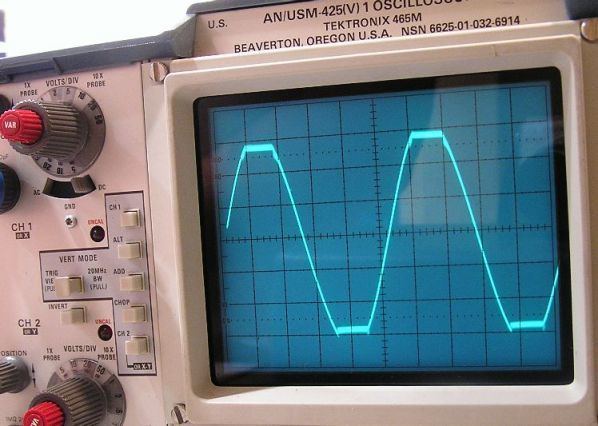 | ||
Clipping is a form of waveform distortion that occurs when an amplifier is overdriven and attempts to deliver an output voltage or current beyond its maximum capability. Driving an amplifier into clipping may cause it to output power in excess of its power rating.
Contents
Overview
When an amplifier is pushed to create a signal with more power than its power supply can produce, it will amplify the signal only up to its maximum capacity, at which point the signal can be amplified no further. As the signal simply "cuts" or "clips" at the maximum capacity of the amplifier, the signal is said to be "clipping". The extra signal which is beyond the capability of the amplifier is simply cut off, resulting in a sine wave becoming a distorted square-wave-type waveform.
Many electric guitar players intentionally overdrive their guitar amplifiers to cause clipping and other distortion in order to get a desired sound.
Amplifiers have voltage, current and thermal limits. Clipping may occur due to limitations in the power supply or the output stage. Some amplifiers are able to deliver peak power without clipping for short durations before energy stored in the power supply is depleted or the amplifier begins to overheat.
Effects
In power amplifiers, the signal from an amplifier operating in clipping has two characteristics that could damage a connected loudspeaker:
As a result, many amplifier designers have incorporated circuits to prevent clipping. Such circuits compare the input signal to the output signal to detect the presence of extra power caused by distortion. The simplest circuits act like a fast limiter, which engages after about one decibel of clipping is detected. A more complex circuit, called "soft-clip", was used from the 1980s onward to limit the signal at the input stage. The soft-clip feature begins to engage prior to clipping, for instance starting at 10 dB below maximum output power. The output waveform retains a rounded characteristic even in the presence of an overload input signal as much as 10 dB higher than maximum specified.
Digital clipping
In digital signal processing, clipping occurs when the signal is restricted by the range of a chosen representation. For example in a system using 16-bit signed integers, 32767 is the largest positive value that can be represented, and if during processing the amplitude of the signal is doubled, sample values of, for instance, 32000 should become 64000, but instead they are truncated to the maximum, 32767. Clipping is preferable to the alternative in digital systems—wrapping—which occurs if the digital hardware is allowed to "overflow", ignoring the most significant bits of the magnitude, and sometimes even the sign of the sample value, resulting in gross distortion of the signal.
Avoiding clipping
As seen on the oscilloscope, the wave resulting from the clipping is not a full sine wave. To avoid this, the overall level of a mix can be lowered, or a limiter can be used to dynamically bring the levels of the loud parts down (for example, bass and snare drums).
It is not simple to eliminate all clipping, as filtering (e.g. a high-pass filter) can align various frequencies in such a way as to create excessive peak outputs. The excessive peaks may become clipped even though the amplifier can play any single sine wave without clipping. As such, some audiophiles will use amplifiers that are rated for power outputs over twice the speaker's ratings.
Repairing a clipped signal
It is preferable to avoid clipping, but if a recording has clipped, and cannot be re-recorded, repair is an option. The goal of repair is to make up a plausible replacement for the clipped part of the signal.
Complex hard-clipped signals (recorded at CD resolution or less) cannot be restored to their original state because the information contained in the peaks that are clipped is completely eliminated. Soft-clipped signals can be restored to their original state to within a case-dependent tolerance because no part of the original signal is completely eliminated. In this case, the degree of information loss is proportional to the degree of compression caused by the clipping. Lightly clipped bandwidth-limited signals that are highly oversampled have a high likelihood of perfect repair.
Several methods can partially restore a clipped signal. Once the clipped portion is known, one can attempt partial recovery. One such method is interpolation or extrapolation of known samples. While this is only an approximation of the original, the subjective quality is usually improved, sometimes with no audible difference.
Other methods may also be used. One of the methods in CuteStudio Declip, for example, works by copying the signal directly from one stereo channel to another, as it may be the case that only one channel is clipped.
Several software solutions of varying results and methods exist to counteract this problem: Sony Sound Forge, iZotope Rx3, Adobe Audition, Nero Wave Editor, and a plugin in the Audacity LADSPA package come with clip restoration software. There is also an Audacity plugin called Clip Fix that uses cubic splines to attempt to restore a continuously differentiable signal.
Detection
Clipping in a circuit can be detected by comparing the original input signal with an output signal that has been adjusted for changes in applied gain. For instance, if a circuit has 10 dB of applied gain, it can be tested for clipping by attenuating the output signal's gain by 10 dB and comparing it to the input signal. If the circuit is driven into clipping, the attenuated output signal will show less voltage in the comparison. The electrical offset between the two signals can be used to illuminate clipping detection indicators, such as a red LED, and can be used to decrease the gain of a preceding circuit so that the level of clipping distortion can be limited.
